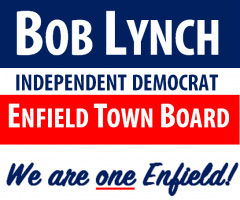Monthly Report
Tompkins County Council of Governments
for December 11, 2024
by Councilperson Robert Lynch
Enfield TCCOG Representative
The Tompkins County Council of Governments (TCCOG) held its final meeting of 2024 on December 5th. Aside from end-of-year housekeeping matters, attention centered on the status and the future of EMS services in Tompkins County and in New York State.
On November 19, the Tompkins County Legislature adopted a Resolution that “calls upon the New York State Assembly to recognize Emergency Medical Services (EMS) as an essential service and to take all necessary steps to ensure that this recognition is implemented state-wide.” The Resolution also stated the County Legislature’s preference that “mandatory coordination of EMS services at the County and inter-County level is the best method to ensure” such preservation of essential service.
A TCCOG endorsement in September prompted the County Legislature to act. The endorsement got little discussion at TCCOG in September. At this month’s meeting, it got far more.
Dryden Councilperson Dan Lamb and Trumansburg Mayor Rordan Hart have driven the initiative. Each comes from a municipality home to a paid ambulance service. And each of those services finds itself answering many emergency calls from outside its own town or village. As many as 40 per cent of Dryden’s calls come from outside Dryden. Fifteen percent of Trumansburg’s calls from outside that community.
And the problem is money. Mayor Hart said the average ambulance call costs a service $1,500. But private insurance may reimburse $950 to $1,100 for that call. Medicare may pay $350, and Medicaid only $127. The services lose money, and the burden invariably falls on a municipality’s taxpayers.
“I’m being polite if I’m saying our Dryden Ambulance folks are unhappy,” Dan Lamb told TCCOG. “They’re angry at this situation, and they’re demanding that their legislators do something about it. They feel unfairly taken advantage of,” Lamb emphasized.
But what to do became the issue of the meeting. The County Legislature has recommended New York State elevate Emergency Medical Service’s stature. But a declaration alone accomplishes little without financial support. And there’s no indication New York State will cough up additional money. The “essential service” designation couldn’t even pass the State Assembly last year.
Speaking for myself alone (since our Town Board had not stated its collective preference), I’d raised concerns about the EMS Resolution before the County Legislature November 19. I cautioned that a New York State directive to localities could turn into an unfunded mandate. It could impose upon Enfield and other smaller towns a requirement to provide for or pay for a local ambulance service.
“It just can’t fall financially on the backs of smaller towns, poorer towns like ours in Enfield,” I warned TCCOG. Instead, I maintained, County Government is in the best position for “coordination and funding centrality.” But, I added, “New York State tends to go the way it wants to go.”
Out of TCCOG’s collective discussion that December day came perhaps a most important take-away: What’s best for Tompkins County in light of the challenges it faces may be a countywide ambulance tax.
“The logical thing… it should be the County,” the Dryden Village’s Mike Murphy said. County taxes should be the funding “funnel,” he concluded. “Otherwise, it’s for me an unfair situation in that it drives up the cost unfairly.”
But little statewide incentive may exist for county-coordinated ambulance services. “We’re only one of two or three counties in the state actively doing this,” Mayor Hart advised. He followed with advice: “Maybe we have to develop the model.”
The “model” was left open-ended during TCCOG’s nearly half-hour discussion. Tompkins County’s governmental representative, Legislature Chair Dan Klein, preferred everyone hold-off on specific s until the State Legislature has time to act, perhaps coinciding with state budget adoption in the spring.
Ulysses Supervisor Katelin Olson raised the counter-argument. “We should not wait for the state,” Olson argued. “We have to find a new direction… I’m skeptical when I think that New York State is necessarily going to fund this and take a leadership role.” Olson maintained the current model is “not sustainable,” that it depends upon sympathetic town and village boards willing to subsidize services beyond their own boundaries. And if they don’t, then “the whole system will collapse,” she warned.
“The only real fair way to finance this, I think, is through a county ambulance tax,” I told TCCOG. It bases funding on an ability to pay, and much of that ability comes from the property tax base. And the tax base weighs disproportionately in and around the City of Ithaca.
But that brings up another problem. Ithaca already has a highly-functioning private ambulance service, Bangs. And as a result, with a countywide ambulance tax, Ithacans may view themselves as giving more than they receive.
“The elephant in the room is the City of Ithaca,” Trumansburg’s Hart acknowledged. “City leadership needs to be wrangled into the conversation more often,” Hart said.
I, myself, have written about the intermunicipal EMS issue and of the dangers inherent in a New York State EMS “essential service” designation that turns into another expensive municipal burden. In that regard, Mayor Hart paid me a compliment.
“I very much enjoy Bob Lynch’s writing,” Mayor Hart told TCCOG. “Just in case anyone is not following his writing, his writing style is fantastic,” Hart said. And regarding the cautionary statements I’ve conveyed about mandates, Hart added, “I’m always sensitive to the fact that anything that comes out of Albany tends to want to not be helpful from a financial standpoint. It’s just their M.O.”
Compliment accepted, and the conversation will continue. TCCOG next meets January 23.
Respectfully submitted,
Robert Lynch, Councilperson
Enfield TCCOG Representative

